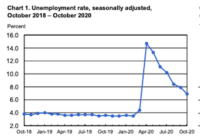Construction posted another monthly employment gain–the industry’s 11th consecutive monthly increase–adding 23,000 jobs in February, the Bureau of Labor Statistics has reported.
BLS said in its latest U.S. employment report, released on March 8, that the heavy and civil engineering construction sector showed the strongest result, with an increase of 12,500 positions.
Two construction segments recorded employment declines and both were relatively modest. Residential specialty trade contractors shed 1,000 positions and residential building firms lost 200.
Architectural, engineering and related services–a separate BLS category from construction–saw its employment rise by 6,400 in February.
Construction’s unemployment rate edged up to 7% in February, from January’s 6.9%. It also increased from the year-earlier level of 6.6%.
The BLS unemployment rates are adjusted for seasonal swings; its jobs totals are seasonally adjusted.
More broadly, BLS reported that overall, the U.S. added 275,000 jobs and its jobless rate climbed to 3.9% in February from January’s 3.7%.
Anirban Basu, Associated Builders and Contractors' chief economist, said in a statement, “In February, we saw evidence that contractors continue to add workers, fulfilling expectations.”
Basu said the gains in various nonresidential segments were “quite remarkable given headwinds such as high project financing costs, elevated construction service delivery costs and lingering recessionary fears.”
Ken Simonson, Associated General Contractors of America chief economist, said in a statement, “Nonresidential contractors stepped up their hiring in February."
But Simonson added that separate BLS data released in recent days on construction job openings and construction spending “suggests hiring would be even more robust if construction firms could find enough qualified workers.”
AGC also noted that February’s average hourly earnings for production and nonsupervisory construction employees rose 4.9 % year over year to $35.21 per hour. The industry’s earnings were 18.5% higher than hourly earnings for all private-sector production employees.





Post a comment to this article
Report Abusive Comment